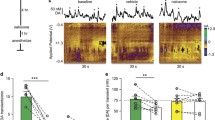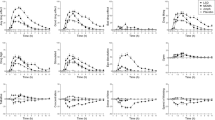Abstract
Indirect evidence has linked opioid reinforcement with changes in noradrenergic metabolism secondary to drug administration. Methodological precedents for biobehavioral correlations in depressive illness have suggested an important association between changes in mood and biogenic amine excretion patterns in the urines of patients during depression and recovery. This paper presents preliminary data on the possible relationship between changes in catecholamine excretion that were observed and the changes in behavior, mood, psychiatric status, and cardiorespiratory physiology secondary to heroin administration and methadone-assisted withdrawal. This study focuses on the urinary excretion of MHPG, since an appreciable fraction of this metabolite is probably derived from norepinephrine originating in the brain. The subjective changes in mood associated with heroin use, the decrease in respiratory rate, and the behavioral and mental status effects associated with opiate intoxication were observed only in the individuals whose MHPG excretion increased during the period of opiate administration.
Similar content being viewed by others
References
Babbini, M., Davis, W. M.: Time-dose relationships for locomotor activity effects of morphine after acute or repeated treatment. Br. J. Pharmacol. 46, 213–244 (1972)
Babor, R. F., Meyer, R. E., Mirin, S. M., McNamee, H. B., Cambria, T. B.: Behavioral and social effects of heroin selfadministration and withdrawal. Arch. Gen. Psychiatry 33, 363–367 (1976)
Clouet, D. H., Johnson, J. C., Ratner, M., Williams, M., Gold, G. J.: The effect of morphine on rat brain catecholamines: turnover in vivo and uptake in isolate synaptosomes. In: Frontiers of catecholamine research, E. Usdin and S. Snyder, eds., pp. 1039–1042. New York: Pergamon 1973
Davis, W. M., Smith, S. G.: Alpha-methyltyrosine to prevent self-administration of morphine and amphetamine. Curr. Ther. Res. 14, 814–819 (1972)
Davis, W. M., Smith, S. G.: Blocking of morphine-based reinforcement by alpha-methyltyrosine. Life Sci. 12, 185–194 (1973)
Davis, W. M., Smith, S. G.: Noradrenergic basis for reinforcement associated with morphine action in nondependent rats. In: Drug addiction, vol. 3, neurobiology and influences on behavior, J. M. Singh and H. Lal, eds. Mt. Kisco: Futura 1974
Eisenman, A. J., Sloan, J. W., Martin, W. R., Jasinski, D. R., Brooks, J. W.: Catecholamine and 17-hydroxycorticosteroid excretion during a cycle of morphine dependence in man. J. Psychiatr. Res. 7, 19–28 (1969)
Gunne, L.-M.: Catecholamines and 5-hydroxytryptamine in morphine tolerance and withdrawal. Acta Physiol. Scand. [Suppl.] 58, 204 (1963)
Gunne, L.-M., Jonsson, J., Fuxe, K.: Effects of morphine intoxication on brain catecholamine neurons. Eur. J. Pharmacol. 5, 338–342 (1969)
Loh, H. H., Hitzemann, R. J., Way, E. L.: Effects of acute morphine administration on the metabolism of brain catecholamines. Life Sci. 12, 33–41 (1973)
Maynert, E. W., Klingman, G. I.: Tolerance to morphine. I. Effects on catecholamines in the brain and adrenal glands. J. Pharmacol. Exp. Ther. 135, 285–295 (1962)
Meyer, R. E., Mirin, S. M., Altman, J. L., McNamee, H. B.: Behavioral paradigm for the evaluation of narcotic antagonists. Arch. Gen. Psychiatry 33, 371–377 (1976)
Milkman, H., Frosch, W. A.: The preferential abuse of heroin and amphetamine. J. Nerv. Ment. Dis. 156, 242–248 (1973)
Mirin, S. M., Meyer, R. E., McNamee, H. B.: Psychopathology and mood during heroin use: acute vs. chronic effects. Arch. Gen. Psychiatry 33, 1503–1508 (1976)
Nelson, J.: Single dose tolerance to morphine sulfate: EEG correlates in central motivational systems. Ph.D. dissertation, Boston University School of Medicine 1970
Olds, J., Milner, P.: Positive reinforcement produced by electrical stimulation of septal area and other regions of the rat brain. J. Comp. Physiol. Psychol. 47, 419–427 (1954)
Overall, J. E., Gorham, D. R.: The brief psychiatric rating scale. Psychol. Rep. 10, 799–812 (1962)
Powell, D. H.: A pilot study of occasional heroin users. Arch. Gen. Psychiatry 28, 586–594 (1973)
Pozuelo, J., Kerr, F. W. L.: Suppression of craving and other signs of dependence in morphine-addicted monkeys by administration alpha-methyl-para-tyrosine. Mayo Clin. Proc. 47, 621–628 (1972)
Rado, S.: Psychoanalysis of pharmacothymia (drug addiction). Psychoanal. Q. 2, 1–23 (1933)
Roffman, M., Reddy, C., Lal, H.: Alleviation of morphine withdrawal symptoms by conditional stimuli: possible explanation for “drug hunger” and “relapse.” In: Drug addiction, vol. 1, experimental pharmacology, J. M. Singh, L. H. Miller, and H. Lal, eds. Mount Kisco, New York: Futura 1972
Roffman, M., Reigle, T., Orsulak, P., Schildkraut, J. J.: The effects of acute and chronic morphine administration on the levels of 3-methoxy-4-hydroxyphenylglycol sulfate in rat brain. Res. Commun. Chem. Path. Pharmacol. 10, 403–417 (1975)
Schildkraut, J. J.: The catecholamine hypothesis of affective disorders: a review of supporting evidence. Am. J. Psychiatry 122, 509–522 (1965)
Schildkraut, J. J.: Neuropsychopharmacology and the affective disorders. Boston: Little, Brown & Co. 1970
Schildkraut, J. J., Meyer, R. E., Orsulak, P. J., Mirin, S. M., Roffman, M., Platz, P. A., Grab, E., Randall, M. E., McDougle, M.: Catecholamine metabolism during heroin use. Presented at the American Psychiarric Association Annual Meeting, Miami, 1976
Sloan, J. W., Eisenman, A. J.: Long-persisting changes in catecholamine metabolism following addiction to and withdrawal from morphine. Assoc. Res. Nerv. Ment. Dis. 46, 96–105 (1968)
Smith, C. B., Villarreal, J. E., Bednarczyk, J. H., Sheldon, M. I.: Tolerance to morphine-induced increases in 14C-catecholamine synthesis in mouse brain. Science 170, 1106–1107 (1970)
Stein, L.: Chemistry of reward and punishment. In: Psychopharmacology: a review of progress, 1957–1967, D. Efron, ed., pp. 105–123. Washington, D.C.: U.S. Government Printing Office 1968
Vogt, M.: The concentration of sympathin in different parts of the central nervous system under normal conditions and after the administration of drugs. J. Physiol. 123, 451–481 (1954)
Way, E. L., Shen, F. H.: Catecholamines and 5-hydroxytryptamine. In: Narcotic drugs: biochemical pharmacology, D. H. Clouet, ed., pp. 229–253. New York: Plenum Press 1971
Weil-Malherbe, H., Smith, E. R. B., Eisenman, A. J., Fraser, H. F.: Plasma catecholamine levels and urinary excretion of catecholamines and metabolites in two human subjects during a cycle of morphine addiction and withdrawal. Biochem. Pharmacol. 14, 1621–1633 (1965)
Wikler, A., Pescor, F. T., Miller, D., Norrell, H.: Persistent potency of a secondary (conditioned) reinforcer following withdrawal of morphine from physically dependent rats. Psychopharmacologia (Berl.) 20, 103–117 (1971)
Author information
Authors and Affiliations
Rights and permissions
About this article
Cite this article
Meyer, R.E., Schildkraut, J.J., Mirin, S.M. et al. Opiates, catecholamines, behavior, and mood. Psychopharmacology 56, 327–333 (1978). https://doi.org/10.1007/BF00432857
Received:
Accepted:
Issue Date:
DOI: https://doi.org/10.1007/BF00432857




